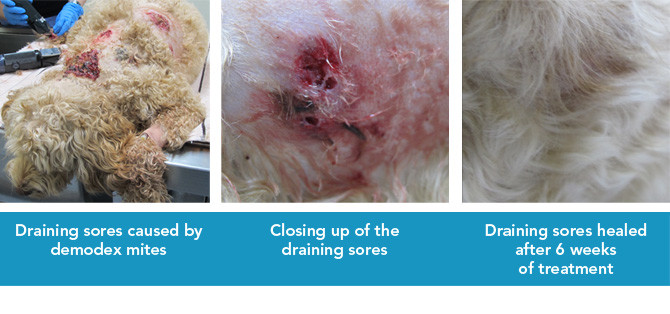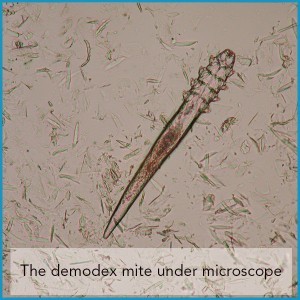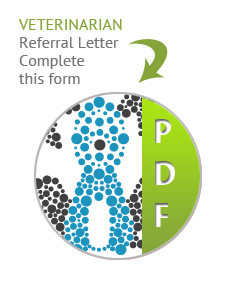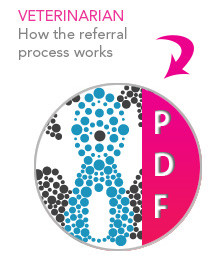The signs of a demodex infection are hair loss, crusting or scaling of the skin, especially around the eyes, mouth and paws, and sometimes red lumps (papules), pimples (pustules) and deep draining sores. Another sign that makes us suspicious that demodex mites are present are areas of blackheads or comedones on the skin. Some dogs and cats are very itchy and some not itchy at all.Demodex is mostly a disease that affects dogs, although cats and other species of animal as well as humans can also get demodex. It has been reported in primates, bats and prairie dogs to name just a few.
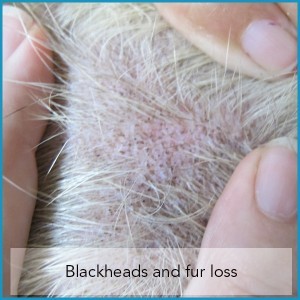
The severity of disease can vary from just one localised patch of hairloss (especially on the head or foreleg) that does not bother the animal at all, to the whole dog or cat being covered in sores and hairloss, and if the infection is particularly bad, it can make the animal very sick indeed – in some cases it may even lead to a blood infection and be fatal.
What is the cause of demodex mites?
The disease is caused by several varieties of mites that are too small to see with the naked eye. They live on the surface of the skin, down in the hair follicles, or in the skin glands that produce oil or sebum. Which variety or varieties of mite is/are present can determine what the signs of infection are – the surface mite tends to make the animal scaly and itchy, the hair follicle mite causes hair loss, papules, pustules and draining sores, and the sebaceous gland mite makes the dog very oily or greasy especially along their back. All of these signs can be complicated by overlying infections with bacteria and or yeast.
My dog has mites, are they contagious?
The mites are not contagious, so they will not be transmitted to other animals or humans that live with the affected animal. There is no need to clean the house or wash the bedding any more than normal. The mites are transmitted from the mother to the puppies or kittens in the first few days of life, and they are a normal part of the flora of animal skin. Humans have their own variety of these mites, and many of us carry them without even noticing. Usually the immune system keeps them in check, and low numbers cause no problems and are not even noticed.
How do I know if my dog has demodex mites?
The time the mites cause a problem is when the mite numbers increase hugely and cause the signs mentioned above – hair loss, crusting, sores, spots, blackheads and greasiness.
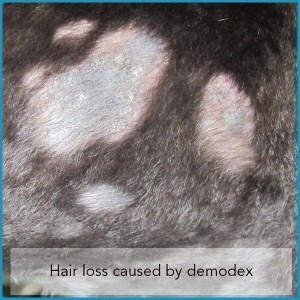
This tends to be either in young animals in their first year or two of life, or middle aged to older adults. It is classified as being either localised, if only a few small areas of the animal are affected, or generalised if several body regions or more than 4-5 areas of skin are affected. Localised infections in young animals may get better on their own, and there also tends to be a good outcome in these cases when they are treated. This is considered within the bounds of normal for a young animal, and there is no need to prevent them from breeding and becoming parents.
What causes dogs to get mites?
If the disease is generalised, it is thought that there is a blind spot in the immune system of that animal, either due to genetics, or immunosuppression due to other diseases such as hormone problems or cancer. Dogs that get generalised demodicosis should not be bred as they may pass on this immune defect to their offspring. We also need to do a thorough health check to work out why the mites have got out of control. In about half of adult dogs with generalised demodex mites, it is possible to find an underlying problem.
How do vets know my dogs has mites?
To look for the mites at the clinic, we do skin scrapings of the superficial layers of the skin to capture the mites, or pull out hairs from hard to scrape areas like around the eyes or on the paws, or take a biopsy of the skin under sedation. We then look for the mites under the microscope.
How do dogs get treated for demodex mites?
There are many options for treatment, and most animals respond very well, although not all. Once treatment has begun it is very important to give it exactly as directed, and not to stop too early. If every mite can be eradicated, the disease should not return, as it is not contagious between adult animals. The most common mistake made is to stop treatment too early while there are still mites present.
